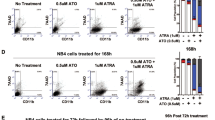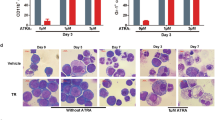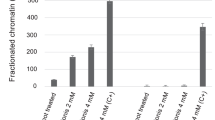Abstract
Aberrant histone acetylation was physiopathologically associated with the development of acute myeloid leukemias (AMLs). Reversal of histone deacetylation by histone deacetylase inhibitor (HDACis) activates a cell death program that allows tumor regression in mouse models of AMLs. We have used several models of PML-RARA-driven acute promyelocytic leukemias (APLs) to analyze the in vivo effects of valproic acid, a well-characterized HDACis. Valproic acid (VPA)-induced rapid tumor regression and sharply prolonged survival. However, discontinuation of treatment was associated to an immediate relapse. In vivo, as well as ex vivo, VPA-induced terminal granulocytic differentiation. Yet, despite full differentiation, leukemia-initiating cell (LIC) activity was actually enhanced by VPA treatment. In contrast to all-trans retinoic acid (ATRA) or arsenic, VPA did not degrade PML-RARA. However, in combination with ATRA, VPA synergized for PML-RARA degradation and LIC eradication in vivo. Our studies indicate that VPA triggers differentiation, but spares LIC activity, further uncouple differentiation from APL clearance and stress the importance of PML-RARA degradation in APL cure.
This is a preview of subscription content, access via your institution
Access options
Subscribe to this journal
Receive 12 print issues and online access
$259.00 per year
only $21.58 per issue
Buy this article
- Purchase on Springer Link
- Instant access to full article PDF
Prices may be subject to local taxes which are calculated during checkout





Similar content being viewed by others
References
Bolden JE, Peart MJ, Johnstone RW . Anticancer activities of histone deacetylase inhibitors. Nat Rev Drug Discov 2006; 5: 769–784.
Minucci S, Pelicci PG . Histone deacetylase inhibitors and the promise of epigenetic (and more) treatments for cancer. Nat Rev Cancer 2006; 6: 38–51.
Insinga A, Monestiroli S, Ronzoni S, Gelmetti V, Marchesi F, Viale A et al. Inhibitors of histone deacetylases induce tumor-selective apoptosis through activation of the death receptor pathway. Nat Med 2005; 11: 71–76.
Nebbioso A, Clarke N, Voltz E, Germain E, Ambrosino C, Bontempo P et al. Tumor-selective action of HDAC inhibitors involves TRAIL induction in acute myeloid leukemia cells. Nat Med 2005; 11: 77–84.
Mikesch JH, Gronemeyer H, So CW . Discovery of novel transcriptional and epigenetic targets in APL by global ChIP analyses: Emerging opportunity and challenge. Cancer Cell 2010; 17: 112–114.
Lin RJ, Nagy L, Inoue S, Shao WL, Miller WH, Evans RM . Role of the histone deacetylase complex in acute promyelocytic leukaemia. Nature 1998; 391: 811–814.
Grignani F, de Matteis S, Nervi C, Tomassoni L, Gelmetti V, Cioce M et al. Fusion proteins of the retinoic acid receptor-alpha recruit histone deacetylase in promyelocytic leukaemia. Nature 1998; 391: 815–818.
Melnick A, Licht JD . Deconstructing a disease: RARalpha, its fusion partners, and their roles in the pathogenesis of acute promyelocytic leukemia. Blood 1999; 93: 3167–3215.
Wang ZY, Chen Z . Acute promyelocytic leukemia: from highly fatal to highly curable. Blood 2008; 111: 2505–2515.
de The H, Chen Z . Acute promyelocytic leukaemia: novel insights into the mechanisms of cure. Nat Rev Cancer 2010; 10: 775–783.
Tallman MS, Altman JK . How I treat acute promyelocytic leukemia. Blood 2009; 114: 5126–5135.
Rego EM, Ruggero D, Tribioli C, Cattoretti G, Kogan S, Redner RL et al. Leukamia with distinct phenotypes in transgenic mice expressing PML/RAR alpha, PLZF/RAR alpha or NPM/RAR alpha. Oncogene 2006; 25: 1974–1979.
Nasr R, Guillemin MC, Ferhi O, Soilihi H, Peres L, Berthier C et al. Eradication of acute promyelocytic leukemia-initiating cells through PML-RARA degradation. Nat Med 2008; 14: 1333–1342.
Ablain J, de The H . Revisiting the differentiation paradigm in acute promyelocytic leukemia. Blood 2011; 117: 5795–5802.
Kogan SC . Curing APL: differentiation or destruction? Cancer Cell 2009; 15: 7–8.
Fenaux P, Le Deley MC, Castaigne S, Archimbaud E, Chomienne C, Link H et al. Effect of all transretinoic acid in newly diagnosed acute promyelicytic leukemia. Results of a multicenter randomized trial. European APL 91 Group. Blood 1993; 82: 3241–3249.
Tallman MS, Andersen JW, Schiffer CA, Appelbaum FR, Feusner JH, Ogden A et al. All-trans-retinoic acid in acute promyelocytic leukemia. N Engl J Med 1997; 337: 1021–1028.
Gallagher RE, Schachter-Tokarz EL, Zhou DC, Ding W, Kim SH, Sankoorikal BJ et al. Relapse of acute promyelocytic leukemia with PML-RARalpha mutant subclones independent of proximate all-trans retinoic acid selection pressure. Leukemia 2006; 20: 556–562.
Gottlicher M, Minucci S, Zhu P, Krämer OH, Schimpf A, Giavara S et al. Valproic acid defines a novel class of HDAC inhibitors inducing differentiation of transformed cells. EMBO J 2001; 20: 6969–6978.
Ferrara FF, Fazi F, Bianchini A, Padula F, Gelmetti V, Minucci S et al. Histone deacetylase-targeted treatment restores retinoic acid signaling and differentiation in acute myeloid leukemia. Cancer Res 2001; 61: 2–7.
He LZ, Tolentino T, Grayson P, Zhong S, Warrell Jr RP, Rifkind RA et al. Histone deacetylase inhibitors induce remission in transgenic models of therapy-resistant acute promyelocytic leukemia. J Clin Invest 2001; 108: 1321–1330.
Warrell RP, He L-Z, Richon V, Calleja E, Pandolfi PP . Therapeutic targeting of transcription in acute promyelocytic leukemia by use of an inhibitor of histone deacetylase. J Natl Cancer Inst 1998; 90: 1621–1625.
Kuendgen A, Strupp C, Aivado M, Bernhardt A, Hildebrandt B, Haas R et al. Treatment of myelodysplastic syndromes with valproic acid alone or in combination with all-trans retinoic acid. Blood 2004; 104: 1266–1269.
Raffoux E, Chaibi P, Dombret H, Degos L . Valproic acid and all-trans retinoic acid for the treatment of elderly patients with acute myeloid leukemia. Haematologica 2005; 90: 986–988.
Bots M, Johnstone RW . Rational combinations using HDAC inhibitors. Clin Cancer Res 2009; 15: 3970–3977.
Zhu J, Zhou J, Peres L, Riaucoux F, Honoré N, Kogan S et al. A sumoylation site in PML/RARA is essential for leukemic transformation. Cancer Cell 2005; 7: 143–153.
Chen Z, Guidez F, Rousselot P, Agadir A, Chen SJ, Wang ZY et al. PLZF-RAR alpha fusion proteins generated from the variant t(11;17)(q23;q21) translocation in acute promyelocytic leukemia inhibit ligand-dependent transactivation of wild-type retinoic acid receptors. Proc Natl Acad Sci USA 1994; 91: 1178–1182.
Slany RK, Lavau C, Clearly ML . The oncogenic capacity of HRX-ENL requires the transcriptional transactivation activity of ENL and the DNA binding motifs of HRX. Mol Cell Biol 1998; 18: 122–129.
Du C, Redner RL, Cooke MP, Lavau C . Overexpression of wild-type retinoic acid receptor alpha (RAR alpha) recapitulates retinoic acid-sensitive transformation of primary myeloid progenitors by acute promyelocytic leukemia RAR alpha-fusion genes. Blood 1999; 94: 793–802.
Zhu J, Nasr R, Peres L, Riaucoux-Lormière F, Honoré N, Berthier C et al. RXR is an essential component of the oncogenic PML/RARA complex in vivo. Cancer Cell 2007; 12: 23–35.
Brown D, Kogan S, Lagasse E, Weissman I, Alcalay M, Pelicci PG et al. A PML RAR alpha transgene initiates murine acute promyelocytic leukemia. Proc Natl Acad Sci USA 1997; 94: 2551–2556.
Westervelt P, Lane AA, Pollock JL, Oldfather K, Holt MS, Zimonjic DB et al. High-penetrance mouse model of acute promyelocytic leukemia with very low levels of PML-RARalpha expression. Blood 2003; 102: 1857–1865.
Minucci S, Monestiroli S, Giavara S, Ronzoni S, Marchesi F, Insinga A et al. PML-RAR induces promyelocytic leukemias with high efficiency following retroviral gene transfer into purified murine hematopoietic progenitors. Blood 2002; 100: 2989–2995.
Lallemand-Breitenbach V, Guillemin M-C, Janin A, Daniel MT, Degos L, Kogan SC et al. Retinoic acid and arsenic synergize to eradicate leukemic cells in a mouse model of acute promyelocytic leukemia. J Exp Med 1999; 189: 1043–1052.
Altucci L, Rossin A, Raffelsberger W, Reitmair A, Chomienne C, Gronemeyer H . Retinoic acid-induced apoptosis in leukemia cells is mediated by paracrine action of tumor-selective death ligand TRAIL. Nat Med 2001; 7: 680–686.
Insinga A, Minucci S, Pelicci PG . Mechanisms of selective anticancer action of histone deacetylase inhibitors. Cell Cycle 2005; 4: 741–743.
Guibal FC, Alberich-Jorda M, Hirai H, Ebralidze A, Levantini E, Di Ruscio A et al. Identification of a myeloid committed progenitor as the cancer-initiating cell in acute promyelocytic leukemia. Blood 2009; 114: 5415–5425.
Wojiski S, Guibal FC, Kindler T, Lee BH, Jesneck JL, Fabian A et al. PML-RARalpha initiates leukemia by conferring properties of self-renewal to committed promyelocytic progenitors. Leukemia 2009; 23: 1462–1471.
Ablain J, Nasr R, Bazarbachi A, de The H . Oncoprotein proteolysis, an unexpected Achille's Heel of cancer cells? Cancer Discovery 2011; 1: 117–127.
Bug G, Gul H, Schwarz K, Pfeifer H, Kampfmann M, Zheng X et al. Valproic acid stimulates proliferation and self-renewal of hematopoietic stem cells. Cancer Res 2005; 65: 2537–2541.
De Felice L, Tatarelli C, Mascolo MG, Gregorj C, Agostini F, Fiorini R et al. Histone deacetylase inhibitor valproic acid enhances the cytokine-induced expansion of human hematopoietic stem cells. Cancer Res 2005; 65: 1505–1513.
Schwarz K, Romanski A, Puccetti E, Wietbrauk S, Vogel A, Keller M et al. The deacetylase inhibitor LAQ824 induces notch signalling in haematopoietic progenitor cells. Leuk Res 2011; 35: 119–125.
Bug G, Schwarz K, Schoch C, Kampfmann M, Henschler R, Hoelzer D et al. Effect of histone deacetylase inhibitor valproic acid on progenitor cells of acute myeloid leukemia. Haematologica 2007; 92: 542–545.
Lallemand-Breitenbach V, Zhu J, Kogan S, Chen Z, de The H . Opinion: how patients have benefited from mouse models of acute promyelocytic leukaemia. Nat Rev Cancer 2005; 5: 821–827.
Kogan SC, Hong SH, Shultz DB, Privalsky ML, Bishop JM . Leukemia initiated by PMLRARalpha: the PML domain plays a critical role while retinoic acid-mediated transactivation is dispensable. Blood 2000; 95: 1541–1550.
Matsushita H, Scaglioni PP, Bhaumik M, Rego EM, Cai LF, Majid SM et al. In vivo analysis of the role of aberrant histone deacetylase recruitment and RAR alpha blockade in the pathogenesis of acute promyelocytic leukemia. J Exp Med 2006; 203: 821–828.
Wu WS, Vallian S, Seto E, Yang WM, Edmondson D, Roth S et al. The growth suppressor PML represses transcription by functionally and physically interacting with histone deacetylases. Mol Cell Biol 2001; 21: 2259–2268.
Pearson M, Carbone R, Sebastiani C, Cioce M, Fagioli M, Saito S et al. PML regulates p53 acetylation and premature senescence induced by oncogenic Ras. Nature 2000; 406: 207–210.
Insinga A, Monestiroli S, Ronzoni S, Carbone R, Pearson M, Pruneri G et al. Impairment of p53 acetylation, stability and function by an oncogenic transcription factor. EMBO J 2004; 23: 1144–1154.
Fortson WS, Kayarthodi S, Fujimura Y, Xu H, Matthews R, Grizzle WE et al. Histone deacetylase inhibitors, valproic acid and trichostatin-A induce apoptosis and affect acetylation status of p53 in ERG-positive prostate cancer cells. Int J Oncol 2011; 39: 111–119.
Kawano T, Akiyama M, Agawa-Ohta M, Mikami-Terao Y, Iwase S, Yanagisawa T et al. Histone deacetylase inhibitors valproic acid and depsipeptide sensitize retinoblastoma cells to radiotherapy by increasing H2AX phosphorylation and p53 acetylation-phosphorylation. Int J Oncol 2010; 37: 787–795.
Cote S, Rosenauer A, Bianchini A, Seiter K, Vandewiele J, Nervi C et al. Response to histone deacetylase inhibition of novel PML/RARalpha mutants detected in retinoic acid-resistant APL cells. Blood 2002; 100: 2586–2596.
Mercurio C, Minucci S, Pelicci PG . Histone deacetylases and epigenetic therapies of hematological malignancies. Pharmacol Res 2010; 62: 18–34.
Acknowledgements
ML was supported by the Ramon Areces Foundation and currently by a Marie Curie Intra-European Fellowship (under Grant Agreement PIEF-GA-2009-254256). The de Thé laboratory is supported by the Ligue Nationale contre le Cancer, INSERM, CNRS, University Paris Diderot (formerly known as Paris-7), the Institut Universitaire de France, EPITRON (an integrated project funded by the European union under the 6th framework program (LSHC-CT-2005-518417)) and Canceropole programs. Work in the Minucci's group is supported by AIRC, MIUR, MIS and EPITRON. We thank Maria Rosaria Cera, Marco Cirò and Pietro Spinelli for suggestions, discussions and technical help. We thank J Godet and the Comité des Yvelines de la Ligue contre le Cancer for their continuous trust and support.
Author contributions
SMi and HT designed research and wrote the manuscript; SMo and ML performed research, analyzed and interpreted data and wrote the manuscript; IP collected data; CM analyzed data; and RDZ HS and LP performed experiments.
Author information
Authors and Affiliations
Corresponding author
Ethics declarations
Competing interests
The authors declare no conflict of interest.
Additional information
Supplementary Information accompanies the paper on the Leukemia website
Supplementary information
Rights and permissions
About this article
Cite this article
Leiva, M., Moretti, S., Soilihi, H. et al. Valproic acid induces differentiation and transient tumor regression, but spares leukemia-initiating activity in mouse models of APL. Leukemia 26, 1630–1637 (2012). https://doi.org/10.1038/leu.2012.39
Received:
Revised:
Accepted:
Published:
Issue Date:
DOI: https://doi.org/10.1038/leu.2012.39



